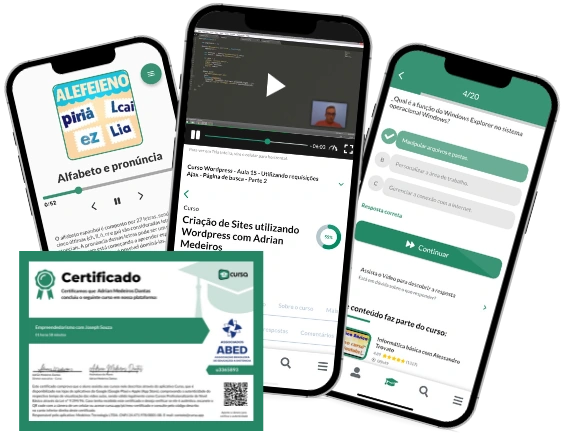
Free online courseNetwork Programming
Duration of the online course: 3 hours and 26 minutes
New course
Learn network programming with this free course covering web clients, multithreaded servers, socket handling, and more. Ideal for web development enthusiasts.
In this free course, learn about
- Foundations of Socket-Based Network Programming
- Concurrent and Scalable Servers
- High-Level Networking Tools and User Experience
- Practical Networking Utilities and Protocols
Course Description
Welcome to "Network Programming," a comprehensive course designed for those eager to delve into the world of web development through the lens of information technology. This course offers a blend of practical and theoretical knowledge to equip you with the essential skills to build and manage web clients and servers using C programming.
With a duration of 3 hours and 26 minutes, you'll find that this course is packed with valuable content without overwhelming you. Despite its relatively short length, each module is meticulously crafted to ensure you gain a deep understanding of network programming principles and their real-world applications. The course is tailored for those in the web development subcategory and offers an engaging learning experience, even though it is currently awaiting its first reviews.
The journey begins with an introduction to building web clients using sockets, setting the foundation for more advanced topics. You'll then progress to programming your own web server in C, a crucial skill for any aspiring web developer. Understanding how socket servers can get client addresses will be explored through practical examples, emphasizing the significance of functions like accept and inet_ntop.
Endianness issues, a common challenge in programming, are addressed to ensure your applications handle data correctly across different systems. Further, you'll learn how to write a multithreaded server in C, an essential for high-performance web services. This segment includes in-depth discussions on threads and sockets, followed by an additional part on creating thread pools to optimize your server's performance.
Part three of the multithreaded server lessons introduces condition variables, a topic critical for advanced synchronization techniques. The course also dives into how one thread can efficiently listen to multiple sockets using the select function in C, providing a robust approach to building scalable network applications.
Networking is made easier with a segment dedicated to libcurl, a versatile library that simplifies many networking tasks in C. One of the lighter yet intriguing topics is an exploration of why progress bars are often inaccurate, accompanied by a hands-on example in C to illustrate the concept.
To enrich your learning experience, the course includes a code review of a student programming project, offering valuable insights into best practices and common pitfalls. Detecting corruption with checksums is another critical topic, ensuring the integrity of data in your applications.
The versatility of Unix file descriptors is explored through sockets and pipes, showing how they can be seamlessly integrated into your programs. You'll also learn how to get an IP address from a hostname, a fundamental skill for any network programmer.
The course covers the two main types of network sockets, providing a thorough understanding of their differences and use cases. Finally, you'll delve into sending and receiving UDP packets in C, rounding out your network programming skills with a comprehensive look at this connection-less protocol.
Enroll in "Network Programming" today and take your web development skills to the next level in the exciting realm of network programming.
Course content
- Video class: How to build a web client? (sockets) 07m
- Exercise: What key feature of sockets allows programs to communicate over long distances?
- Video class: Program your own web server in C. (sockets) 12m
- Exercise: When creating a basic web server using sockets, what is the main purpose of the 'accept' function?
- Video class: Socket servers can get client addresses. (accept, inet_ntop) 02m
- Exercise: What is the purpose of the inet_ntop function in this context?
- Video class: Dealing with Endianness Issues in your Programs 06m
- Exercise: In network communication, which byte order is considered the standard for network byte order on the Internet?
- Video class: How to write a multithreaded server in C (threads, sockets) 14m
- Exercise: Which of the following techniques is primarily used to enhance server performance by enabling it to handle multiple connections simultaneously?
- Video class: Multithreaded Server Part 2: Thread Pools 08m
- Exercise: What is the primary advantage of using a thread pool in a multi-threaded server?
- Video class: How to write a multithreaded webserver using condition variables (Part 3) 07m
- Exercise: What is the primary function of a condition variable in a multi-threaded server?
- Video class: How one thread listens to many sockets with select in C. 12m
- Exercise: Which of the following best describes the use of the 'select' function in network programming?
- Video class: Easy Networking in C (libcurl) 14m
- Exercise: What advantage does using a library like lib curl provide when adding networking capabilities to a program?
- Video class: Why are Progress Bars Always Wrong? Progress Bar Example in C. 35m
- Exercise: Why are progress bars often considered inaccurate or misleading in software applications?
- Video class: Highlighting a Student Programming Project (Code Review) 12m
- Exercise: What is a key benefit of engaging in personal coding projects when learning programming?
- Video class: Detect Corruption with a Checksum 13m
- Exercise: What is a primary purpose of using checksums in network communication?
- Video class: Sockets and Pipes Look Like Files (Unix/fdopen) 12m
- Exercise: In Unix-style operating systems, why do different components such as pipes, sockets, and files often appear similar to programmers?
- Video class: How to get an IP address from a host name? (Example in C) 18m
- Exercise: In network programming, if you want to convert a domain name into its respective IP address within your C program, which function is utilized to perform this conversion automatically, returning a linked list of possible addresses?
- Video class: The two main types of network socket 06m
- Exercise: In network programming, which type of socket is most appropriate for applications where data reliability is not critical, such as in live video streaming?
- Video class: How to Send and Receive UDP packets (in C) 23m
- Exercise: In network programming with C, when dealing with datagram sockets, which function is specifically used to send UDP packets to a specified address without establishing a connection?
This free course includes:
3 hours and 26 minutes of online video course
Digital certificate of course completion (Free)
Exercises to train your knowledge
100% free, from content to certificate
Ready to get started?Download the app and get started today.
Install the app now
to access the courseOver 5,000 free courses
Programming, English, Digital Marketing and much more! Learn whatever you want, for free.
Study plan with AI
Our app's Artificial Intelligence can create a study schedule for the course you choose.
From zero to professional success
Improve your resume with our free Certificate and then use our Artificial Intelligence to find your dream job.
You can also use the QR Code or the links below.

More free courses at Web Development

Free CourseProgressive Web Application PWA for Beginners

3h24m

15 exercises

Free CourseMySQL Database

3h53m

6 exercises

Free CourseJavaScript for beginners

1h40m

2 exercises

Free CourseUmbraco CMS

6h21m

19 exercises

Free CourseFull Stack Web Development

26h16m

48 exercises

Free CourseAngular 2 for Beginners

1h02m

9 exercises

Free CourseDesign and code a landing page

4h40m

15 exercises

Free CourseJavascript

4h52m

46 exercises

Free CourseHTML and CSS

9h07m

3 exercises

Free CourseWeb Development for beginners

5h21m

30 exercises

Free CourseProgressive Web Application PWA for Beginners
3h24m
15 exercises

Free CourseMySQL Database
3h53m
6 exercises

Free CourseJavaScript for beginners
1h40m
2 exercises

Free CourseUmbraco CMS
6h21m
19 exercises

Free CourseFull Stack Web Development
26h16m
48 exercises

Free CourseAngular 2 for Beginners
1h02m
9 exercises

Free CourseDesign and code a landing page
4h40m
15 exercises

Free CourseJavascript
4h52m
46 exercises

Free CourseHTML and CSS
9h07m
3 exercises

Free CourseWeb Development for beginners
5h21m
30 exercises
Free Ebook + Audiobooks! Learn by listening or reading!
Download the App now to have access to + 5000 free courses, exercises, certificates and lots of content without paying anything!
-
100% free online courses from start to finish
Thousands of online courses in video, ebooks and audiobooks.
-
More than 60 thousand free exercises
To test your knowledge during online courses
-
Valid free Digital Certificate with QR Code
Generated directly from your cell phone's photo gallery and sent to your email

Download our app via QR Code or the links below::.








